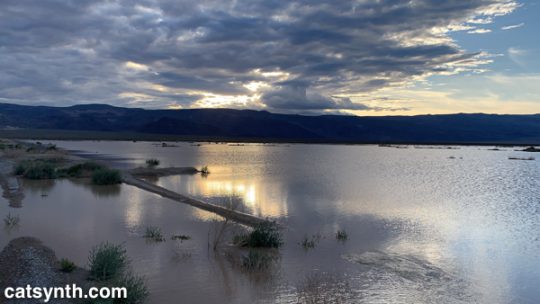We at CatSynth have been following the events at Oroville Dam here in California quite closely. While the worst of the crisis has passed for, we do send our thoughts to those in the along the Feather River and in the low-lying areas along the Sacramento River that remain in danger of flooding, especially during and after massive storm systems like the current one were experiencing.

[Click to enlarge]
Oroville, as the name implies, was an important trading town during the Gold Rush era. It sits at the foothills of the Sierra Nevada along the Feather River which cuts through the mountains. The Oroville Dam was built it the 1960s – it remains the tallest dam in the United States, and Lake Oroville is a rather deep lake – second to Lake Tahoe but a distant second. It also the second largest reservoir in the state.
The landscape in the area is quite beautiful as the water combines with the Sierra foothills as well as the human-made structures, like the dam, the hydroelectric plant and the Bidwell Bar Bridge. The original Bidwell Bar Bridge was the oldest suspension bridge in California. It was relocated when the area – including the town of Bidwell Bar – was flooded in the creation of Lake Oroville and still serves as a pedestrian bridge.

[Jet Lowe [Public domain], via Wikimedia Commons]
A newer suspension bridge replaced it over the lake.

[By Thad Roan from Littleton, CO, USA, http://www.Bridgepix.com (Bidwell Bar Bridge, Oroville, California) [CC BY-SA 2.0], via Wikimedia Commons]
 Highway 162 crosses the bridge, and connects the town of Oroville to Highway 70 and the Sacramento Valley. Highway 162 continues westward towards the wide flat Thermalito Afterbay, a wide shallow reservoir that is part of the Oroville system, and serves both agricultural water delivery and regulation of the main lake and the power plant.
Highway 162 crosses the bridge, and connects the town of Oroville to Highway 70 and the Sacramento Valley. Highway 162 continues westward towards the wide flat Thermalito Afterbay, a wide shallow reservoir that is part of the Oroville system, and serves both agricultural water delivery and regulation of the main lake and the power plant.
 Highway 70 heads southwards towards Sacramento, passing the towns of Marysville and Yuba City , where it continues as a freeway towards Sacramento. Yuba City is interesting as the home to perhaps the largest Sikh community outside the state of Punjab in India. Many of the Sikh settlers in the area became farmers, in particular peach farmers. And the town hosts a large annual festival that brings in thousands from outside the area.
Highway 70 heads southwards towards Sacramento, passing the towns of Marysville and Yuba City , where it continues as a freeway towards Sacramento. Yuba City is interesting as the home to perhaps the largest Sikh community outside the state of Punjab in India. Many of the Sikh settlers in the area became farmers, in particular peach farmers. And the town hosts a large annual festival that brings in thousands from outside the area.

[By Jujhar.pannu (Own work) [CC0], via Wikimedia Commons[]
The volume of water in the lake, its height, and the dramatic contrast between the foothills and fertile flat low-lying Sacramento Valley make Lake Oroville a “lynchpin” of the California water system, but also quite dangerous in the event of a dam failure. We should be clear that currently the main dam is sound, it is the main spillway and emergency spillway off to the side suffered damane rainstorms. But that could still send large volumes of water to flood large areas of the valley below. The original evacuation order (lifted before the current storm system) covered Oroville, Yuba City and other communities along the rivers. The danger in terms of a catastrophic event would also extend to the Sacramento River and the delta, where numerous “islands” exist below sea level and are protected by an aging levy system.
We hope everyone along these vital waterways remains safe. And as the Oroville Dam system is repaired and upgrade, hopefully this provides the state the proverbial “kick in the tuchus” to address the rest of our aging infrastructure.






 Highway 162 crosses the bridge, and connects the town of Oroville to Highway 70 and the Sacramento Valley. Highway 162 continues westward towards the wide flat Thermalito Afterbay, a wide shallow reservoir that is part of the Oroville system, and serves both agricultural water delivery and regulation of the main lake and the power plant.
Highway 162 crosses the bridge, and connects the town of Oroville to Highway 70 and the Sacramento Valley. Highway 162 continues westward towards the wide flat Thermalito Afterbay, a wide shallow reservoir that is part of the Oroville system, and serves both agricultural water delivery and regulation of the main lake and the power plant. Highway 70 heads southwards towards Sacramento, passing the towns of Marysville and Yuba City , where it continues as a freeway towards Sacramento. Yuba City is interesting as the home to perhaps the largest Sikh community outside the state of Punjab in India. Many of the Sikh settlers in the area became farmers, in particular peach farmers. And the town hosts a large annual festival that brings in thousands from outside the area.
Highway 70 heads southwards towards Sacramento, passing the towns of Marysville and Yuba City , where it continues as a freeway towards Sacramento. Yuba City is interesting as the home to perhaps the largest Sikh community outside the state of Punjab in India. Many of the Sikh settlers in the area became farmers, in particular peach farmers. And the town hosts a large annual festival that brings in thousands from outside the area.









